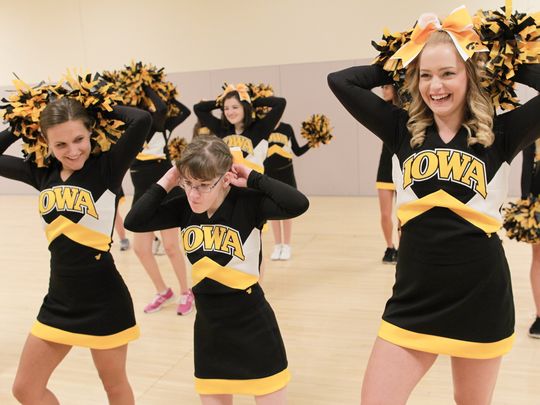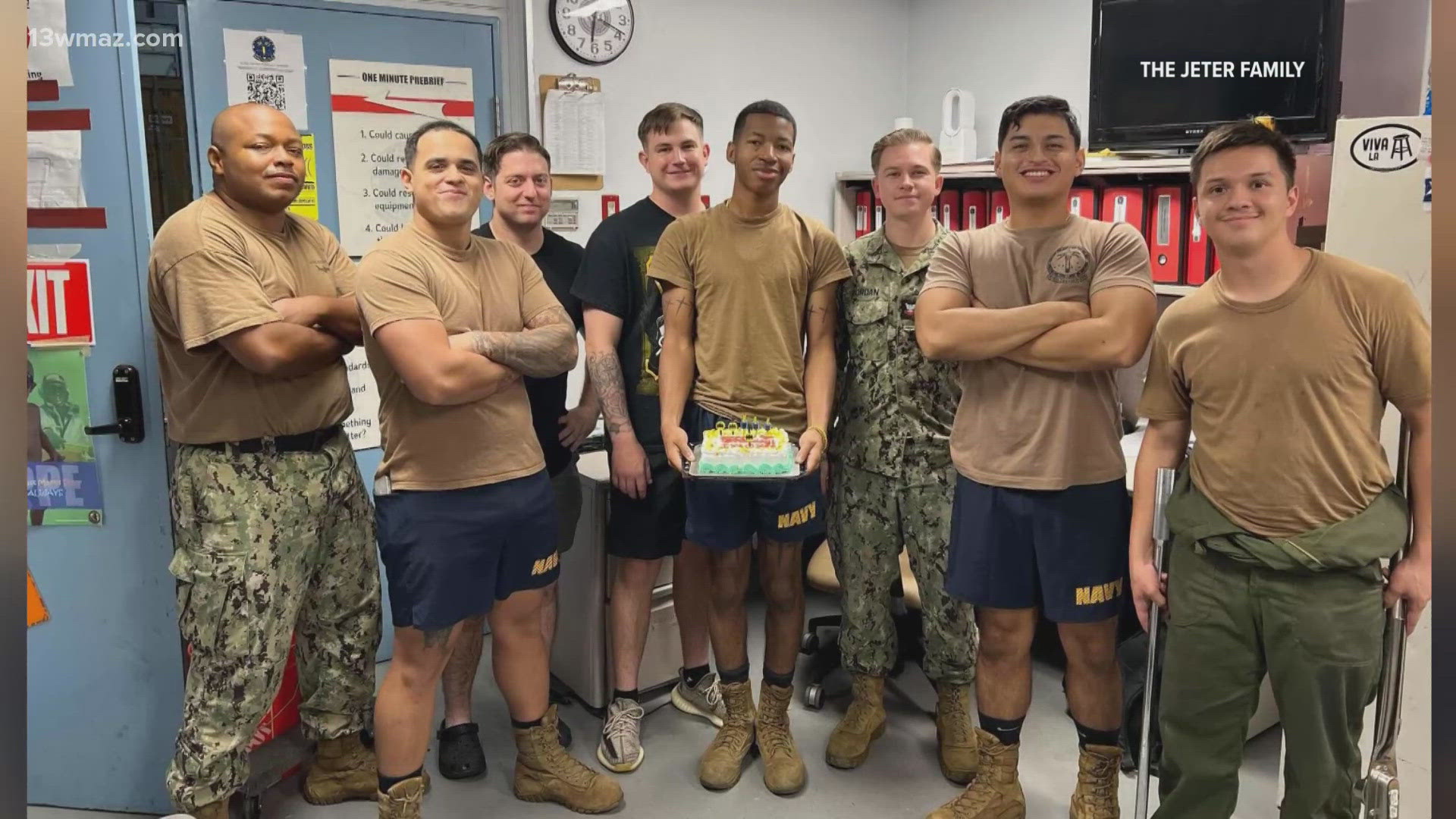DES MOINES, Iowa - Keira Kelly squirmed with the tenuous excitement of a girl readying to open a soda can she's just finished shaking. Dressed to the nines in a black and gold University of Iowa cheerleading uniform and clutching a Hawkeye-emblazoned backpack, Kelly focused with rapt attention on the nondescript dance studio’s door.
Soon, Katie Lipes came bounding in, ready to throw her arms around Kelly, and stopped short. “What are you wearing?” the 19-year-old, who has Down syndrome, asked incredulously.
“My new uniform,” Kelly said, holding out the backpack. “And here, there’s one for you, too.”
While the pair looked the part of Iowa cheerleaders and knew the Hawkeye routines inside and out, Kelly and Lipes are so much more than cheerleaders. They are Sparkles.
The Sparkle Effect, a nonprofit founded in 2008 by 15-year-old Iowan Sarah Cronk, helps high schools and universities start inclusive “Sparkle” squads, cheer or dance teams that combine typically developing students and students with disabilities. So far, the group has founded more than 168 Sparkle teams in 29 states and interest continues to grow every year, Cronk said.
The idea for the Sparkle Effect came to Cronk, now 23, when she noticed systemic exclusion of students with disabilities from activities in her high school. These classmates weren’t so much bullied as they were ignored, "walking through the hallways without a single person looking at them or smiling at them," she said.
Which is why the word “inclusive” comes up over and over when you talk to Cronk or Linda Mullen, her mother and the Sparkle Effect’s executive director. A Sparkle squad is not a team of solely disabled teens, it is a team that very purposely mixes kids of all abilities, they emphasize.
“We as a society have decided that segregation is not OK anymore and yet there are still organizations creating separate programs just for kids with disabilities,” Cronk said.
“If we aren’t crossing social boundaries, can we really say we’re being as inclusive as possible?” she continued. “If we aren’t including people from all walks of life in our activities, can we really say we’re as inclusive as possible?”
Inclusion changes lives, Cronk added, accentuating the changes.
And she would know because she’s seen the staggering power of simply being included change a life within her own family.
![14 photos: Meet the Iowa Sparkle Effect cheerleaders [gallery : 83913676]](http://www.gannett-cdn.com/-mm-/ca75f61e16c593054911bcc7d184b3173c747e38/c=0-0-1872-1600/local/-/media/2016/05/04/IAGroup/DesMoines/635979469462756366-IOW-0317-Hawkeye-Sparkles-05.jpg)
Charlie
Cronk’s older brother Charlie, who is on the autism spectrum, had a hard time when he started at Pleasant Valley High School just before Sarah. He was always very bright and very socially motivated, Mullen said, but he was a bit socially awkward.
He didn’t have a place to land in the hallways or in the cafeteria, she said. He’d eat lunch in the nurses’ office and came to dread school.
Then, a member of the school’s swim team asked Charlie to sit with him at lunch and, eventually, to join the team.
Charlie went from anxious every day to excited, Mullen said. It was a complete 180 that both Mullen and Cronk pinpoint to the moment Charlie found “a team.”
“Being on that team truly changed his life,” Cronk said.
Cronk took note of her older brother’s experience. And one day after cheer practice, the idea hit her like a freight train: What if we had students with physical and intellectual disabilities join us for practice and perform for part of every game? Would people want to join? Would they want to watch?
She approached her coach and the administration and got a tentative yes. They told her she could try it out for one game, Cronk remembered, but if things didn’t go well, the experiment was over.
So during the season’s first football game, in front of a packed house, the newly formed Sparkles took the field.
“We had no idea if it would be good or awful or how the crowd would react,” Cronk said. “But it was really magical, everyone loved it and the entire stadium stood up when we finished.”
Cronk paused: “A million things could have gone wrong, really, but instead a million things went right.”
![635984907043996149-635979469212842764-IOW-0317-Hawkeye-Sparkles-12.jpg [image : 84193968]](http://www.gannett-cdn.com/media/2016/05/10/USATODAY/USATODAY/635984907043996149-635979469212842764-IOW-0317-Hawkeye-Sparkles-12.jpg)
Madison
The Hawkeye Sparkles practice began with socializing and dancing to hits from Justin Bieber and One Direction. Some girls stayed close to their able-bodied cheer partners, but others flitted from conversation to conversation.
In the center of it all was Madison Shults, 13, a Sparkle cheerleader from Iowa City. She shook her hips to Bieber’s “Baby” and did a handstand, triumphantly raising her fists when she returned upright.
Her mother, Jennifer, sat with the other parents and clapped to the beat, shrieking when Madison whipped out her gymnastics move.
“She is so introverted and this has brought her out of her shell,” Jennifer Shults said. “I mean, look, nobody is staring at her, she just gets to be herself. She puts all of her energy into this and she spends all week looking forward to it. She’ll ask, ‘Is it Sparkles day?’”
Her voice caught in her throat: “It makes me really emotional actually. There hasn’t been anything like this in her life before.”
Many other Hawkeye Sparkle parents echoed this story: Finally, their daughter has a place to just have fun, to not feel so different.
Cronk hears stories like this all time, too, she said. But she’s quick to add that both groups of students, typically developing and those with disabilities, are “learning and growing in equal measure.” Being a part of Sparkles isn’t an act of charity by the typically developing students, Mullen said.
Karly Dankert, 22, one of the founders of the Hawkeye Sparkles, was on a Sparkle squad associated with her high school’s dance team. Her dance partner was a girl who had Down syndrome who she’d known her entire school career.
In elementary school, the pair would hang out after school, but as they grew older they drifted apart, Dankert said. Then the Sparkles offered them a new way to find common ground.
“She enjoyed dance and I enjoyed dance and we could connect over our shared interest, so we started spending more time together,” Dankert said. “She was always positive and I tried to learn from her and instill that sort of unbridled happiness into my life.
“And as the team grew and grew, the atmosphere in the hallways changed,” she added. “Because of Sparkles, people went out of their way to reach out to students who were different than themselves.”
Lauren
Laughter and echoes of “You go girl!” bounced off the wall at a recent performance of the Cyclone Sparkles, Iowa State University’s Sparkles team.
Lauren Grace, 21, who has fetal alcohol syndrome, had stuck all the routine's moves and even been lifted up by her fellow teammates at the end of their routine — her favorite part, she said.
After, she and the other Sparkles settled into the stands to watch the university’s cheer team practice for the upcoming national competition. At the beginning of one of their routines, a girl was thrown high into the air.
“Wow,” Grace marveled. “Just look at that. That’s what I want to do. I am going to practice every day.”
When Cronk set out to create an inclusive team, she chose cheerleading because she was a cheerleader, but also because they needed a sport that could be modified to fit any ability. Cheer moves can be made simpler and routines can be as short as necessary, Cronk said. And, in many disability communities, making sure to get enough exercise is a major issue.
“Parents come up to me and say they have seen their child move in a new way,” Dankert, a human physiology major, said. “Some girls aren’t able to stretch or kick their leg up high, but even them lifting their foot up off the ground when they hear the music is something to be proud of.”
Cronk also chose cheerleading because of its visibility. When she started her Sparkle team, the goal was to change game night in Bettendorf. The best way she could think of doing that was putting differently abled peers in her school’s colors and having the entire group loudly and proudly show Pleasant Valley spirit.
“You can only get that from cheerleading,” she said.
![635984908088429539-635979469221110817-IOW-0317-Hawkeye-Sparkles-10.jpg [image : 84194038]](http://www.gannett-cdn.com/media/2016/05/10/USATODAY/USATODAY/635984908088429539-635979469221110817-IOW-0317-Hawkeye-Sparkles-10.jpg)
The next generation
The Sparkle Effect is one of those activities that grabs your heart and holds on, said Mara Mapes, the captain of the Cyclone Sparkles, and it’s helped her discover her life’s passion.
“From Sparkles, I’ve figured out I want to work with people,” Mapes said. “I want to take all the things I’ve learned from Sparkles — treating people right, integrity, being authentic and genuine to everyone no matter what — and make it a job.”
When Cronk founded her nonprofit, her goal was to start Sparkle squads at 100 schools, a marker she's beaten almost twice over. (In Iowa, all three public universities have a Sparkles squad and metro-area high schools are adding teams regularly, including Waukee in 2013 and Johnston last fall.)
Within the last few years, Cronk has seen complete Sparkle team turnover at certain schools, meaning the teams have been in existence for five years or longer and the original founder has graduated.
“Now, the students at those schools have never known any other way except being inclusive,” Cronk said. “It’s no big deal and it’s just accepted instead of discussed endlessly.”
Because, really, the goal of the Sparkle Effect is to eventually not need the Sparkle Effect, Mullen said, to get to the point where “inclusion is the norm.”
For Mullen, Cronk and many others touched by being on a Sparkle Effect team, inclusion is more than an extracurricular, it is a way of life.
“Our organization started to create inclusive cheer squads, but now we are trying to advance all forms of social inclusion,” Mullen said. “And we’re getting there — slowly.
“But until total inclusion happens,” she added, “we'll be out there on game night, on the field, cheering loudly.”


![635984907712464719-635979627184276324-IMG-5961.JPG [image : 84194032]](http://www.gannett-cdn.com/media/2016/05/10/USATODAY/USATODAY/635984907712464719-635979627184276324-IMG-5961.JPG)
